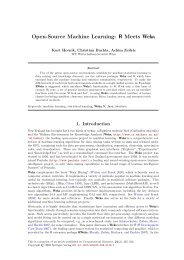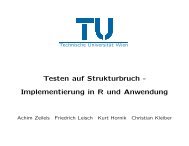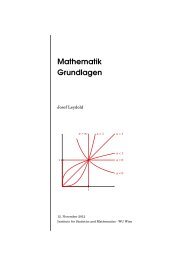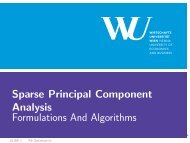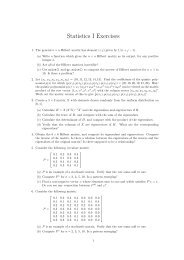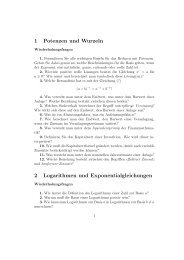Implementing a Class of Structural Change Tests - Institute for ...
Implementing a Class of Structural Change Tests - Institute for ...
Implementing a Class of Structural Change Tests - Institute for ...
You also want an ePaper? Increase the reach of your titles
YUMPU automatically turns print PDFs into web optimized ePapers that Google loves.
A. Zeileis / Computational Statistics & Data Analysis 50 (2006) 2987–3008 6the package strucchange (Zeileis, Leisch, Hornik, and Kleiber 2002; Zeileis, Kleiber, Krämer, andHornik 2003)—mainly in the new functions gefp and efpFunctional—which is, like R itself,available at no cost under the terms <strong>of</strong> the general public licence (GPL) from the comprehensiveR archive network at http://CRAN.R-project.org/. There<strong>for</strong>e, the s<strong>of</strong>tware can not only beused by everyone interested, the whole source code can be inspected. Hence, with the wordingfrom Claerbout’s principle (see Leisch and Rossini 2003, <strong>for</strong> a discussion), this article is not onlyan advertisement <strong>for</strong> a scholarship (in <strong>for</strong>m <strong>of</strong> the strucchange package), the scholarship itself isalso freely available. This assures easy reproducibility <strong>of</strong> the results in this paper; an issue whichreceived increased attention in both statistics and econometrics (McCullough and Vinod 2003).3 Generalized M-fluctuation processes3.1 TheoryIn structural change problems, it is <strong>of</strong> interest to test the hypothesis that the parameters <strong>of</strong> acertain model remain constant over all observations against the alternative that they change over“time”.More <strong>for</strong>mally, we have a parametric model with k-dimensional parameter θ i <strong>for</strong> n ordered observations<strong>of</strong> a possibly vector-valued variable Y i (i = 1, . . . , n). Under the assumption that <strong>for</strong> eachobservation at time i there is a parameter θ i such that the model holds, the null hypothesis is thatthe parameters are constant over the full sample periodH 0 : θ i = θ 0 (i = 1, . . . , n)which is tested against the alternative that θ i changes over “time”. The tests described in thefollowing have power against various patterns <strong>of</strong> departures from parameter constancy. In timeseries applications, the observations are typically ordered with respect to time, but different orderingsmay be more natural in other applications: e.g., ordering with respect to a specific prognosticfactor in biometric studies or with respect to income in economic models.The idea <strong>of</strong> the tests is to estimate the parameter vector once <strong>for</strong> all n observations based on anM-estimation score function ψ(·) which has zero expectation at the true parameters E(ψ(Y i , θ i )) =0 and to use the (scaled) cumulative sum process <strong>of</strong> these scores to detect instabilities in theparameters. The full sample M-estimator is implicitly defined byn∑ψ(Y i , ˆθ) = 0. (1)i=1This includes various estimation techniques as special cases, such as ordinary least squares (OLS),maximum likelihood (ML), instrumental variables (IV), (generalized) estimating equations (GEE),robust M-estimation, Quasi-ML. Generalized method <strong>of</strong> moments (GMM) is also closely relatedto this class <strong>of</strong> estimators.Under parameter stability, the scores ψ(Y i , ˆθ) have zero mean but under the alternative there willbe systematic deviations from zero which can be captured using the cumulative sum process <strong>of</strong>the scores:⌊nt⌋∑W n (t) = n −1/2 ψ(Y i , ˆθ). (2)It can be shown that <strong>for</strong> this process a functional central limit theorem (FCLT) holds which impliesthat the process W (·) converges to a process Z(·) that is a Gaussian process with zero mean andcovariance function COV[Z(t), Z(s)] = min(t, s) · J, where J is the (asymptotic) covariance matrix<strong>of</strong> the scores ψ. Usually, this covariance structure can easily be estimated, the simplest estimatorbeing∑ nĴ = n −1 ψ(Y i , ˆθ)ψ(Y i , ˆθ) ⊤ , (3)i=1i=1Copyright © 2005 Elsevier B.V.





